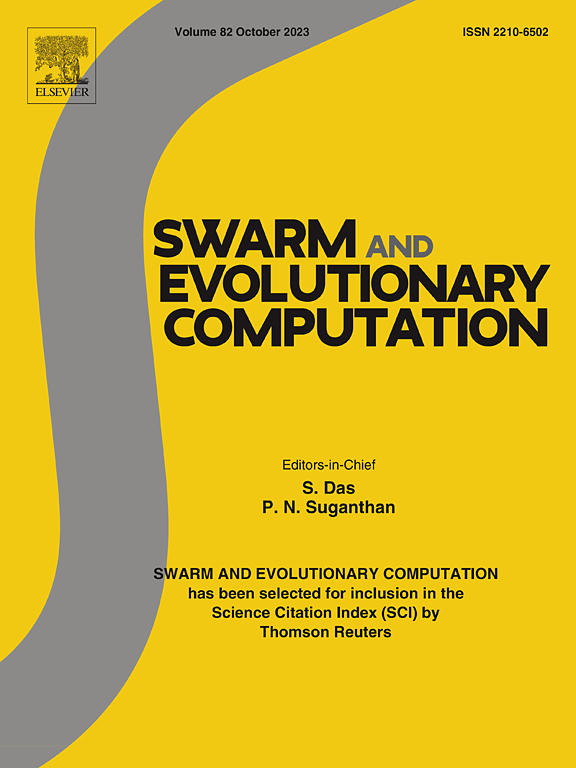动态约束多目标进化优化的可行性引导搜索与预测
IF 8.5
1区 计算机科学
Q1 COMPUTER SCIENCE, ARTIFICIAL INTELLIGENCE
引用次数: 0
摘要
动态约束多目标优化问题具有目标和约束随时间变化的特点,提出了两个主要挑战:(1)在进化搜索中平衡可行性、收敛性和多样性;(2)为新环境生成有效的初始种群。为了解决这些问题,本文提出了一种具有可行性引导搜索和预测的动态约束多目标进化算法(FGSP),该算法将可行性引导进化搜索(FGES)和可行性信息引导预测(FIGP)相结合。具体而言,FGES通过监测不可行解的比例和时间相关的不可行容忍度阈值,自适应调整进化策略,从而可以在没有约束的情况下进行探索,在大的不可行区域中导航,并在受限的Pareto前沿附近进行可行性驱动开发,以优化解决方案,从而平衡收敛性、可行性和多样性。同时,FIGP利用经过历史可行方案训练的人工神经网络来预测新环境的高质量初始种群,通过从过去环境中学习的模式显著加快对动态变化的适应。在最新的基准问题和一个实际问题上,将所提出的FGSP算法与五种最先进的算法进行了比较,实验结果验证了FGSP算法在获得可行非支配解方面的有效性。本文章由计算机程序翻译,如有差异,请以英文原文为准。

Feasibility-guided search and prediction for dynamic constrained multiobjective evolutionary optimization
Dynamic constrained multiobjective optimization problems (DCMOPs) are characterized by the variations of both objectives and constraints over time, posing two main challenges: (1) balancing feasibility, convergence, and diversity in the evolutionary search and (2) generating an effective initial population for new environments. To address these problems, this paper proposes a dynamic constrained multiobjective evolutionary algorithm with feasibility-guided search and prediction (called FGSP), which integrates a feasibility-guided evolutionary search (FGES) and a feasible information guidance prediction (FIGP). Specifically, FGES adaptively adjusts evolutionary strategies by monitoring the proportion of infeasible solutions and a time-dependent tolerance threshold for infeasibility, such that it can perform exploration without constraints to navigate through large infeasible regions and conduct feasibility-driven exploitation to refine solutions near the constrained Pareto front, thereby balancing convergence, feasibility, and diversity. Concurrently, FIGP utilizes an artificial neural network trained on historically feasible solutions to predict a high-quality initial population for new environments, significantly accelerating adaptation to dynamic changes via pattern learned from past environments. After comparing the proposed FGSP with five state-of-the-art algorithms on the latest benchmark problems and one real-world problem, the experimental results validate the effectiveness of FGSP in obtaining feasible non-dominated solutions.
求助全文
通过发布文献求助,成功后即可免费获取论文全文。
去求助
来源期刊

Swarm and Evolutionary Computation
COMPUTER SCIENCE, ARTIFICIAL INTELLIGENCEC-COMPUTER SCIENCE, THEORY & METHODS
CiteScore
16.00
自引率
12.00%
发文量
169
期刊介绍:
Swarm and Evolutionary Computation is a pioneering peer-reviewed journal focused on the latest research and advancements in nature-inspired intelligent computation using swarm and evolutionary algorithms. It covers theoretical, experimental, and practical aspects of these paradigms and their hybrids, promoting interdisciplinary research. The journal prioritizes the publication of high-quality, original articles that push the boundaries of evolutionary computation and swarm intelligence. Additionally, it welcomes survey papers on current topics and novel applications. Topics of interest include but are not limited to: Genetic Algorithms, and Genetic Programming, Evolution Strategies, and Evolutionary Programming, Differential Evolution, Artificial Immune Systems, Particle Swarms, Ant Colony, Bacterial Foraging, Artificial Bees, Fireflies Algorithm, Harmony Search, Artificial Life, Digital Organisms, Estimation of Distribution Algorithms, Stochastic Diffusion Search, Quantum Computing, Nano Computing, Membrane Computing, Human-centric Computing, Hybridization of Algorithms, Memetic Computing, Autonomic Computing, Self-organizing systems, Combinatorial, Discrete, Binary, Constrained, Multi-objective, Multi-modal, Dynamic, and Large-scale Optimization.
 求助内容:
求助内容: 应助结果提醒方式:
应助结果提醒方式:


